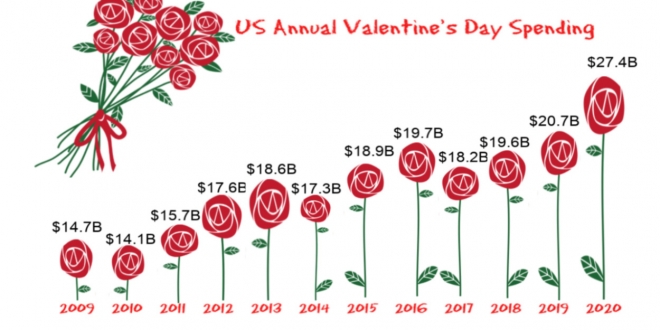
US consumers are expected to spend more than $27.4 billion this year on Valentine’s Day, an increase of 32% from last year. That’s enough to make many retailers’ hearts grow fonder for sure.
The National Retail Federation (NRF) said US retail sales grew 2.7% in January, setting up nicely for another happy Valentine’s Day for retailers.
Last year, US consumers spent a record $20.7 billion showing their love, including $886 million on their pets. This year looks even bigger.
Record spending in their hearts
So, what’s driving this year’s big jump in spending plans?
“Valentine’s Day is a sentimental tradition, but gift-giving can be driven by the economy,” NRF President and CEO Matthew Shay said. “Consumers spent freely during the 2019 winter holidays and they appear ready to do the same in the new year. The same strong employment numbers and higher wages that boosted holiday sales should make it easier to spend a little extra to say, ‘I love you’ this year and to spread the gift-giving beyond just your significant other.”

The NRF expects consumers to spend an average of $196.31, up 21% over last year’s previous record of $161.96.
The unusually large increase in average spending appears to be due to stronger consumer finances and a continued trend of consumers buying more gifts, cards, candy, and flowers for friends, family, co-workers and yes, pets.
The increase in total spending comes as the number of people celebrating Valentine’s Day returned to 55%, about average for the past decade, after a dip to 51 % last year.
Spouses and significant others will receive 52% of the love or an average of $101.21 this year, up from $93.24 in 2019. That share of spending on closest loved ones is still down from 61% a decade ago.
The good news for Fido and Meow is that Valentines’ spending on pets doubled to 6% from 3% in the past decade. 27% of consumers will buy something for their pets this year says the NRF.
As well, in the same timeframe, consumers will spend 7% on gifts for coworkers compared to 3% ten years ago. Not sure if it’s just family squabbles but other family members have seen a drop from 20% to 15% of spending in the past decade.
What’s on the Valentine’s Day gift list?

Shoppers plan to spend $5.8 billion on jewelry (given by 21%), $4.3 billion on an evening out (34%), $2.9 billion on clothing (20%), $2.4 billion on candy (52%), $2.3 billion on flowers (37%), $2 billion on gift cards (19%) and $1.3 billion on greeting cards (43%).
Gifts of experience such as tickets to an event or a trip to a spa are wanted by 41% and planned by 28%. Got that noted, hubby?
Department stores are the most popular Valentine’s Day shopping destination, visited by 36%, with discount stores and online tied at 32%, specialty stores at 19%, florists at 17%, local small business at 15% and clothing stores and jewelry shops tied at 11% each.
Fun Valentine’s Day facts
Fortunly shares a few more fun Valentine’s Day shopping facts:

- 85% of greeting cards are bought by women
- 25% of Americans will shop or Valentine’s Day gifts for their loved ones
- 28% of shoppers bought plants or flowers as gifts (37% men, 19% women)
- dentists will be pleased that $1.8 billion was spent last year on candy
- men do spend five times more than women on gifts
- the first Valentine was sent in 1415 by Charles, Duke of Orleans in a poem to his wife while he was imprisoned in the Tower of London
- the first heart-shaped chocolate box was sold in 1861 by Richard Cadbury
- as many as 6 million couples get engaged on Valentine’s Day
- Valentine’s Day is banned nationwide in several Muslim-majority states including Iran, Pakistan, Saudi Arabia, Malaysia, Indonesia, and India although many celebrate it privately
So, how will you celebrate your Valentine’s Day? Online, in-store or at home, we hope it’s sweet for you!

